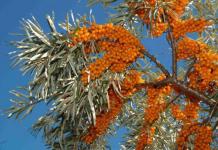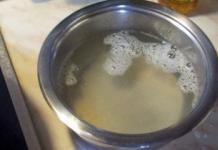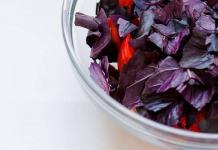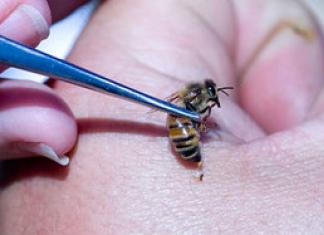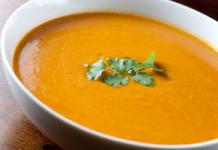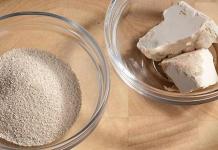Find out about the beneficial properties of hot pepper - is it possible for pregnant women to eat it, what contraindications exist, as well as the composition and calorie content.
The content of the article:
Hot red pepper is a spice, burning aromatic seasoning. It is the fruit of a tropical shrub of a certain variety Capsicum frutescens or C. annuum. The pods are dried and then ground into powder. There are also names for this product - bitter pepper or chili (chilli pepper - red pepper), which everyone has heard. In cooking and trade, the name "cayenne" is used, which distinguishes it from the less pungent varieties.

In the photo, a shrub of hot chili pepper
Hot peppers come from the tropics of America. The shrub itself is low, about half a meter, has many oval leaves, the flowers are large, light with purple spots. During the fruiting period, round or elongated multi-colored berries of yellow, red, dark olive colors appear on its branched stems. Now it is grown almost everywhere, but it occupies a special place in Thailand and India. Hot peppers are used in cooking, medicine, and cosmetology.
The use of hot pepper
There are two main types of peppers: cayenne and vegetable. The first species has small light orange fruits, in contrast to the second, and when ground is much lighter than its counterpart. The stronger aroma and hotter taste of red pepper is due to capsaicin (a phenolic compound found in veins, seeds, skins), which is not present in bell peppers. When they want to reduce the "burning heat" in food, the veins and seeds are simply removed.
Cooking is unthinkable without pepper: any of the species is suitable not only as a seasoning. For example, red chili is used fresh, cooked (stewed, roasted) and dried. Pepper pods are used in vegetable dishes, in canning, and dried pepper is ground and added to kefir, salads, soups, added to meat, marinades. Small fruits are fried, if the skin is thick, then it is first removed. Generally, it is difficult to imagine a dish that does not require the addition of pepper, especially in Asian countries. It is very popular with us, the recipe came to us from Abkhazia.

To preserve the pods of the hot seasoning for the long winter, it is strung on a thread and hung in a dry place. This is also the case in Mexico with large chili peppers, because their national cuisine loves to cook hot sauces. Before cooking, dried pods are cleaned of veins and seeds, and so that they do not become bitter, they are fried for several minutes in a hot frying pan, then soaked in hot water and ground into a mashed paste.
Peppers of any kind, fried and frozen, will not lose their taste and useful qualities. Want to freeze fresh? Not a problem: dip it in boiling water for a couple of minutes, remove it, cool it, wrap it in a bag and place it in the freezer.
Medicine also uses red hot peppers. Its "burning substances" are appreciated. It is precisely this kind of shrub capsicum that is used to create a tincture. Such a burning liquid, if taken orally, improves digestion, stimulates appetite, and kills pathogens. And who hasn't treated muscle pain with a sticky pepper plaster? In general, in medicine, no less than in cooking, hot pepper is popular: for shock, fainting, collaptoid conditions, heart attacks, internal bleeding, lack of blood circulation, etc.
For example, in Asian countries - India, Thailand, Vietnam, hot pepper is the king of spices and at the same time an antibacterial agent. In the tropics, because of the heat, microbes multiply very quickly, so all dishes are spicy. To reduce the risk of poisoning or contracting an infectious disease, hot peppers are heavily consumed even by pregnant women, with absolutely no risk of giving birth before term. In northern countries, chile is forbidden to eat women during lactation and while waiting for a newborn, fearing that a large rush of blood to the organs will cause contractions. But in southern countries, even children are born with a "hardened character".
The chemical composition and calorie content of bitter pepper
Fresh peppers are very juicy and contain 88% water. The calorie content of hot chili peppers (raw) per 100 g is 40 kcal, as well as:
- Protein about 2 g
- Carbohydrates about 8 g
- Fat - 0.2 g
- Dietary fiber - 1.59 g
- Mono- and disaccharides - 5.11 g
- Saturated fatty acids - 0.02 g
- A - 59 mcg
- Beta-carotene - 0.7 mg
- C - 242.48 mg
- B1 thiamine - 0.09 mg
- Riboflavin B2 - 0.08 mg
- (niacin) - 0.059 mg
- B6 pyridoxine - 0.3 mg
- B9 - 22.9 mcg
- PP - 0.1 mg
- E - 0.7 mg
- K - 14 mcg
- Choline - 11 mg
- Potassium - 341 mg
- Phosphorus - 45.9 mg
- Magnesium - 25.1 mg
- Calcium - 18.1 mg
- Sodium - 7 mg
- Copper - 173.9 mcg
- Iron - 1.22 mg
- Selenium - 0.44 mcg
- Zinc - 0.29 mg
- Manganese - 0.2 mg
Useful properties of red hot pepper

The pungency of red pepper is the most valuable quality of this vegetable. Without raising the temperature, it heats the place where the soaked pepper powder is applied (in the common people, mustard plaster). As under the influence of high temperature, the blood vessels dilate, the supply of nutrients and oxygen to tissues and organs improves, pain relief (where there is spasm) and healing (where there is inflammation) occurs.
For severe headaches, hot pepper tincture can be rubbed into the nose. Severe headaches disappear after 1–3 days. This was confirmed by American scientists when they conducted this test on students. See the video below for more details.
Spicy peppered food does not spoil longer, and besides, once it gets into the stomach, it kills pathogenic microbes.
The cosmetics industry makes extensive use of hot peppers in anti-cellulite creams, balms and oils to thicken hair. Very popular among fashionistas to lose weight -,
Hot pepper is filled with B vitamins, trace elements (potassium, iron, magnesium), essential and fatty oils. Ripe red peppers are still rich in vitamins A and C, unlike unripe ones. When consumed with food, all this usefulness enters our body and has a beneficial effect on health.
The harm of hot chili peppers
A useful pungency for some people may be harmful to others. So, contraindications - hot pepper can worsen the health of patients with angina pectoris, hypertension, arrhythmia, it will damage its intake to unhealthy kidneys and liver. People with gastritis and ulcers, with diseases of the intestinal tract can get burned, bleeding and get to a hospital bed. Therefore, it is dangerous to immediately add this spice to food in large quantities.
It is also worth talking about some of the warnings in interacting with hot peppers. For example, there are varieties that can easily irritate the skin from just touching them. If you are preparing a dish with pepper, then be careful - do not touch your eyes. Wash your hands and dishes thoroughly. Hot peppers eaten through carelessness are useless to wash down with water, it is better to "cool the ardor" with milk or yogurt, although the pungency can be easily interrupted with sour - lemon, for example.
For pregnant women, it is not harmful, as we wrote above - in Asian countries, chili is actively eaten by pregnant women.

Shown with red and green chili sauce, soy sauce, vinegar or lime juice
- Fresh fruits of hot peppers are light in color, but as soon as they are dried, they become brighter in color, darken.
- In nature, there is a bird - a red-factor canary, so that its feather color acquires a more intense color, it is periodically fed with cayenne red pepper.
- Red hot peppers are unpretentious. It can also be grown at home, on a windowsill in an ordinary flower pot, for example. Do not forget to just water and feed it regularly.
- Officially the hottest pepper in the world for 2012 is Carolina Reaper (1.6 million SHU "Scoville heat units"). He took this title from the red pepper Trinidad Moruga Scorpion (1.2 million SHU), named by the champion a little earlier, in February 2012. Both peppers are varieties of Chinese capsicum (Capsicum chinense).

This product is widely used in everyday life, cooking, cosmetology and in some other areas. What are its properties? Is it really useful or harmful? More on this later.
History
This product is widely used as a spice. Perhaps many will be surprised, but there are several of its species, which are brought from different countries of the world: India, East Asia, America. Depending on the country in which the pepper was grown, it has different taste properties: some of them are distinguished by a high level of pungency, and some are more pungent, which is noticeable when you first touch the ground seasoning.
This product settled on the territory of Russia quite a long time ago - in the 16th century. Even then, it was brought by merchants and, due to its high cost, was used only by wealthy people. Later, they began to grow it in the regions of the Krasnodar Territory and the Volga region - it is these lands that are currently considered the most acceptable for the cultivation of this agricultural crop.
Vitamins
Red pepper has beneficial properties due to the presence of trace elements and minerals in its composition, which have a certain effect on the human body. So, in the composition of each peppercorn there is a considerable content of carotene, due to which its red color is ensured. In addition, experts highlight the high content of vitamins of the B, C and A groups in the structure of such a product.In addition to all this, in the structure of pepper one can observe such components as proteins and sugar, as well as a high content of essential oils, which are very often used in medicine and cosmetology.
In addition to all this, among the useful components you can find such names as phosphorus, sodium, as well as selenium and zinc, which have the most beneficial effect on various systems of human organs. In addition to vitamins and microelements, red hot pepper contains several types of fatty acids: oleic, capric, palmitoleic, myristic, and lauric. In addition, this fresh seasoning has a low content of Omega-3 and Omega-6.

Beneficial features
It is considered a very useful component, especially if it is used correctly in cooking. This seasoning is able to awaken the appetite, thereby improving the functioning of the digestive system of the body. In addition, it has a beneficial effect on the work of the pancreas, stimulating it to produce vital enzymes.
Some doctors have noticed the beneficial properties of red hot pepper, which are aimed at the work of the heart and blood vessels. According to many studies, people who regularly eat red pepper do not have vision problems. However, this feature applies only to those people who consume red chili peppers - those who like to use it in ground form as a seasoning can not be fooled. Often such a product is used for the prevention and treatment of arthritis and rheumatism.
Negative properties
As you know, even the most useful foods, if consumed excessively or incorrectly, can be harmful. The same rule applies to peppers. A separate risk area that should be paid attention to by all fans of such a product is the gastrointestinal tract, since it is in this part of the body that it has the most active effect. Chili recipes are not suitable for those people who suffer from diseases such as gastritis, stomach ulcers, intestinal ulcers, or other diseases associated with the digestive system. It should also be avoided by those who suffer from liver disease, as well as diabetes.
Such a product is contraindicated for pronounced allergy sufferers. Its enzymes can only exacerbate the manifestations of such a disease.
Cooking applications
Most often, ground pepper is used in the preparation of all kinds of dishes. Many experts recommend that you definitely add it to food, which is characterized by a difficult digestion process, in particular, in meat dishes. Nutritionists, in turn, note the low calorie content of pepper and its positive effect on metabolism.
A spice such as red hot pepper is widely used in cooking in combination with other spices and herbs. Many culinary experts recommend pairing it with nutmeg or chocolate. The spice added in the correct proportion can give the finished sauce not only an original aroma, but also a noble red tint.
In its pure form, the vegetable can be pickled or added to alcoholic homemade infusions.

Application in cosmetology
A large number of cosmetologists also pay attention to the benefits and harms of red pepper. In particular, the essential oils of this product are used to make anti-cellulite cream or as part of warming cosmetics. The product shows an excellent effect in the process of burning fat deposits - which is why it is often used for wraps.
The positive properties of such a product in hair loss have long been known. In the event that there is such a problem, it is enough to periodically rub the pepper tincture into the scalp. As practice shows, as a result of this application, the hair will not only become stronger, it will look healthier, and its growth will also noticeably accelerate.
Hand and nail masks that contain pepper or pepper extracts also have a positive effect. As a result of their regular use, a significant strengthening of the nail plate, as well as its growth, will be noticeable. In addition, this procedure helps to prevent the appearance and development of the fungus.
Application in medicine
Knowing about the benefits and dangers of red pepper, you can widely use it in medicine. This product is incredibly useful in this area due to its burning properties.
A slice of pepper will be an excellent way to bring a person to their senses in case of fainting - it must be placed under the tongue. Rubbing their legs with them, you can save a person from hypothermia of the feet, and rubbing with the development of inflammatory processes or flu will immediately prevent the progression of ailments.
Hot peppers have excellent antipyretic properties that can be used at the very beginning of an infection in the body. In order to prevent its spread, you should stir the ground seasoning with honey in a 1: 1 ratio and eat one teaspoon three times a day. In order for the mass to have a more pleasant taste, it can be mixed with milk.
In medicine, pepper plasters are widely used, which can be purchased at pharmacies in any city. They are prescribed for arthritis, rheumatic pain, and muscle and joint diseases. Special attention is also paid to plasters, which are prescribed for colds - they are glued in the throat and chest. If necessary, you can prepare such a remedy yourself: for this you need to chop the slightly dried fruits of the vegetable and, after rewinding the mass with gauze, attach it to the sore spot.

Other uses of red pepper
Few know the results of some observations of scientists, which also indicate the benefits of red pepper in any form. So, they note that this product perfectly cheers up those who use it regularly, even in small portions. In addition, not so long ago, well-known oncologists conducted a study, during which they found that such a product prevents cell mutation, which prevents the formation of cancerous tumors. Of course, in the modern world, when tumor diseases have become quite common, this discovery plays an important role.
Dangers of external use
How to use red pepper for external use correctly? After all, many are aware of its irritating and scalding properties. First of all, you should pay attention to the fact that the skin on which the composition with such an ingredient will be applied does not have a high level of irritability and does not have any damage in the form of wounds or scratches. It is also not recommended to use such a component for those people who experience problems with veins, and those whose skin is prone to allergic reactions.
Speaking about the benefits and harms of red pepper, many lovers of using this product through external use give some advice in case a skin burn was nevertheless obtained. If this happens, it is enough to lubricate the damaged area with vegetable oil, after rinsing the area with plain water. Thus, it is possible to reduce painful sensations, as well as accelerate the process of regeneration of skin cells.

How to store
In order for red pepper not to lose its properties, it is necessary to organize proper storage for it. So, the best conditions for a fresh legume vegetable can be arranged in the refrigerator, after wrapping it in cling film or a plastic bag. In this form, it can be stored for no more than one week - otherwise it will begin to fade and, as a result, lose its invaluable properties. In order to increase the period of possible storage, you can pre-treat the vegetable pods with vegetable oil or vinegar - in this form, it will stay fresh for one month.
It is not recommended to store the pepper in ground form for a long period - it quickly loses its properties: for example, after two to three days it will be unsuitable for treatment. If you wish to keep the product dry, it is best to tie it up and hang it in a dark and dry place.

How to choose the right pepper
When purchasing pepper in the market or in a store, you need to pay attention to its appearance - it is he who speaks about how useful the product will be.
In the event that you need to purchase a fresh vegetable, you should give preference to red pods - the brighter their color, the more vitamins they contain. In appearance, it should be smooth and shiny, and very elastic to the touch - this indicates the freshness of the vegetable.
In the event that dried peppers are purchased, then you also need to pay attention to the color. The ideal pepper will be dark red and of a solid color. In the event that the fruit has orange blotches, you should avoid buying it, as this indicates harmful bacteria that have settled in it during the drying process - such a spice is unsuitable for food. The dried pepper must have an ideal surface, there can be no cracks on it - their presence indicates the loss of nutrients.

For pregnant women and children
Most doctors do not recommend that pregnant women eat any form of red pepper. According to them, this product can adversely affect the development of the fetus. In addition, a woman, eating even a small amount of red pepper during pregnancy, runs the risk of getting heartburn, which can only cause discomfort. While breastfeeding, the use of such a product is also not recommended. This is due to the fact that, through breast milk, the components that make up the pepper will enter the stomach of a small child and cause heartburn in him, as well as more serious diseases of the digestive system. Pediatricians generally do not recommend giving a baby spicy foods and dishes for food - they adversely affect the gastric mucosa, as well as health in general.
Red peppers are one of the most amazing vegetables in their composition. It contains more than 40 vitamins, 20 minerals, as well as many other useful substances that help to improve the condition of many body systems. The opinion that hot peppers only cause gastritis and nothing else is absolutely wrong, since the benefits of this vegetable and its medicinal properties, which help with a number of diseases, have been scientifically proven. Everyone knows pepper mustard plasters, tinctures and even mixtures for inhalation against tonsillitis and bronchitis.
As for the composition, first of all, it should be noted the high content of capsaicin, which includes in its structure vitamins C and A. Thanks to this substance, hot pepper is used as a drug for the treatment of the central nervous system and sensory disorders. Many medical institutions in Europe use the extract in the manufacture of diabetic drugs, as well as for the treatment of people with psoriasis or arthritis.
With over 20 enzymes in hot chili peppers, it promotes better digestion. Despite the fact that many argue that it is dangerous for the stomach, this opinion is extremely subjective. Some enzymes and acids that the human body secretes in the digestive tract have a much higher pungency than the most "evil" Habanero. Other varieties of this vegetable can be used as an effective laxative. It also contains a large amount of organic substances that suppress appetite. Thus, chili red pepper is used as an effective weight loss aid.



Chili pepper - benefits for the body
There are a number of diseases in which the properties of hot peppers can significantly help fight the symptoms and the disease itself. Consider some situations where chili can heal the human body, or significantly help in treatment.
- High blood pressure. As you know, with increased pressure, it is necessary to expand blood vessels and normalize the work of the heart. This vegetable has just such properties - chili pepper contains many antioxidants and macromolecules that have a beneficial effect on the body and, in particular, on the circulatory system. Already after 4-5 days of including green hot pepper in your diet, you will notice a significant improvement in general condition and a decrease in blood pressure.
- Cancer diseases. It has been observed that people who consume a lot of chili have 90% fewer cancer problems. Direct dependence has not yet been scientifically proven, since studies are being conducted on the properties of the vegetable, but statistics indicate its healing properties.
- The pungency of red pepper is beneficial for infectious diseases. More than 80% of bacteria die when interacting with juice, therefore it is used for infectious tonsillitis, gastric and intestinal disorders, and drink for poisoning.
- Fortifying action. People who often eat chili have significantly higher immunity, in particular due to the many vitamins and constant disinfection of the intestinal tract.
After several reasons, it is already possible to accurately answer the question of what is hot pepper - benefit or harm. As you can see, the positive aspects are already enough to include the vegetable in the diet. Moreover, in terms of the amount of vitamins contained in the pulp, as well as in relation to other useful substances, it is several times superior to aloe, and even echinacea.
Hot peppers - benefits and harms, or more
Chile has been controversial among scientists for decades about its harm. So is it worth giving up the daily use of it in food? Let's consider in more detail all the "threats" to our health from this small pod.
- The first myth is that a vegetable causes gastritis and ulcers. Theoretically, this is possible, since if it is abused, the amount of burning substances in the stomach will increase significantly and exceed the norm. But a vegetable can lead to an ulcer and even gastritis (more precisely, to aggravate) only when the disease has already begun to progress. The juice itself will not be able to infect the walls of the stomach, since they are exposed to much more acid corrosion every day.
- The second myth is that chili causes cancer. Some scientists have tried to prove that if this vegetable is abused, you can get stomach cancer. There have been many studies of patient records from Mexico City. On average, 1 person consumes 2 fresh chili pods a day there. Among 10,000 examined cards, only 2 people had cancer, while in other countries up to 15-19 people on average. It can be assumed that the vegetable, on the contrary, kills viruses and bacteria in the body, and significantly improves it. Moreover, when an extract from red pepper is added to a cancer tumor, pest cells die by 35%, therefore, thorough studies of this effect are being carried out today.
- Pain relievers based on hot peppers are addictive and narcotic. In fact, this statement was the result of a "broken phone", since there were really such powerful drugs in the beginning. But it was far from chili that caused addiction, and even more so it has no narcotic effect.
The only real possible harm is damage to the mucous membrane of the eyes, since some varieties have an extremely high pungency and, upon contact, can even cause burns. Follow the simplest precautions and use the vegetable only for its intended purpose, and this will never happen. Take care of your health and remember that only the abuse of pepper can cause disease - eat it in moderation!
Chili pepper is used in cooking in many countries. Some eaters highly value this vegetable, while others practically cannot stand it. The pungency of the pods is due to the fact that the substance capsaicin is present in a high concentration in them. About 2000 varieties of vegetables have been bred in the world, and you can grow some of them even in an apartment. Find out what chili pepper is, what are the benefits and harms to the human body from its use.
The calorie content of red chili peppers is low: 100 g of the product contains only 40 kcal. The nutritional value of a vegetable is high, since it contains the following substances important for the human body:
- potassium;
- magnesium;
- sodium;
- iron;
- phosphorus;
- zinc;
- thiamine;
- niacin;
- vitamin C;
- retinol (vitamin A);
- vitamin B;
- vitamin K.
Hot chili peppers have the following ratio of proteins, fats and carbohydrates (BJU):
- carbohydrates - 79%;
- proteins - 17%;
- fats - 4%.
The components from the pods have a beneficial effect on the human body, helping to improve health and prevent the occurrence of a number of diseases. The hottest chili has the maximum amount of capsaicin - Trinidad Moruga Scorpion.
Useful properties for the body
The vegetable's capsaicin has been studied in medical laboratories. As a result, studies have shown that chili pepper has the following medicinal effects on the human body:
- antineoplastic;
- anti-inflammatory;
- antiseptic;
- pain reliever;
- hypoglycemic.
Hot green peppers also contain capsaicin, and therefore the benefits are almost the same.
General research on the plant has identified other health benefits of chili as well. Regular addition of this vegetable to food has a variety of positive effects on the human body.

- Prevention of diseases of the heart and blood vessels. Capsaicin helps in lowering bad cholesterol and raising good cholesterol levels. This prevents the formation of atherosclerotic plaques, promotes the dissolution of fibrin accumulations, which are the main reason that blood clots form in the vessels. It is noted that in countries where chili is regularly consumed by the population, the number of heart attacks and strokes is several times lower. This proves once again the beneficial properties of chili peppers.
- Reducing excess weight. The burning substances in the pods stimulate the active burning of fatty deposits due to the acceleration of metabolic processes in the body and increased heat release. At first, the vegetable may seem very spicy, and then you need to use it, starting with a minimum amount, gradually increasing the portion.
- Destruction of cancer cells in the pancreas. Simultaneously with the burning of abnormal cells, chili does not affect healthy ones. This property of a vegetable is explained by the fact that peoples whose food is included in large quantities are much less likely to encounter this form of cancer.
- Elimination of migraines. Cleansing blood vessels and increasing the elasticity of their walls, when using hot pepper, can relieve migraine attacks and almost completely eliminate the problem. Medicines, unlike chili, only temporarily relieve pain, without completely eliminating the disease.
- Prevention of pathologies of the stomach and intestines. Antiseptic and anti-inflammatory properties. Regular consumption of hot vegetables destroys the pathogenic microflora, which causes pathologies such as stomach and duodenal ulcers, as well as gastritis. Because chili has antibacterial properties, it can also be used to treat a number of stomach infections. At the same time, if there are already diseases, the use of a vegetable is strictly prohibited, since it will only provoke a deterioration in the patient's condition, actively corroding the places of already existing erosion.
- Elimination of potency problems. The benefit of chili peppers for men is that it increases testosterone levels. Problems with potency, as a rule, arise precisely because of its insufficient amount and, less often, due to atherosclerosis of the vessels of the small pelvis. Chile eliminates both problems and therefore restores potency and libido. A study on this property of hot peppers was conducted in France and involved over 100 men.
- Increased bone strength. The microelements included in its composition are responsible for this action of the product. Against the background of an increase in metabolic processes in the body, they are actively accumulating in the bones, which reduces their fragility and reduces the risk of osteoporosis. Also, with regular use, this product avoids age-related problems with the spine.
- Improving immunity. The high antiseptic properties of the vegetable help to improve the body's resistance to pathogenic bacteria and viruses. Natural immunity is greatly enhanced. Vitamins in hot red pepper additionally stimulate this process.
- Sugar-lowering action. With the regular use of red hot pepper, it is possible to achieve a decrease in sugar levels, and in some cases, its complete normalization, even with diabetes that has already begun to develop. If you are prone to illness, the use of chili is recommended as a preventive measure to prevent the appearance of health problems. However, if there are severe diseases of the pancreas, the harm of hot peppers can be significant.
- Removal of the depressive state. By consuming the pods regularly, it is possible to increase the natural production of endorphins, a hormone that is responsible for improving mood and preventing depression. Until depression becomes severe, it can be eliminated with only one hot vegetable.

The hotter the pepper is consumed, the more capsaicin the body receives and the higher the benefits of the product. Red hot pepper is useful for humans not only fresh, but also dried. During the cooking process, a ground vegetable loses some of the nutrient, and therefore its consumption should be higher in comparison with what is recommended if there is a capsicum.
Is hot pepper good for pregnancy and nursing mothers?
During pregnancy and breastfeeding, the use of spicy foods is not recommended, which also applies to chili peppers. If you really want spicy, you can allow a little pepper in combination with other products. A small portion of the vegetable will not harm the mother and child.You should not eat chili regularly during pregnancy. It aggressively affects the mother's body, and there is a risk that substances from the vegetable are able to penetrate the placental barrier. It is impossible to predict how they will affect the development of the developing fetus in each specific case. There is always a danger that peppers can be harmful.
When breastfeeding, the use of hot peppers by the mother is also not recommended. Some of the substances from its composition with breast milk will enter the child. Because of this, various disorders in the condition of the baby can be provoked, which will require treatment. This applies to both the consumption of dried vegetables and fresh chili.
Although there are no strict prohibitions on the use of chili pepper for pregnant and lactating women, it is better not to risk it and limit its amount.
How red hot pepper is used for weight loss
Despite its ability to increase appetite, hot pepper does not provoke weight gain, but, on the contrary, stimulates its decrease and activates the process of burning fat cells. The sharper the product, the more effective it is in the fight against excess weight. The body spends a lot of energy to break down capsaicin, and the burning sensation it causes further accelerates energy expenditure.

For weight loss, hot peppers are recommended as an additive to food or in the form of a tincture, drunk before meals. The existing method of replacing food with chili tincture in water or lemon juice is not safe for health and is highly discouraged.
A rather extreme way to reduce weight is wrapping with pepper. Coffee and cinnamon are also added to this ingredient. It is advisable to consult a doctor beforehand. The benefits of hot peppers for weight loss are obvious, but only if there are no contraindications to use for health reasons.
Harm and contraindications of use
The use of hot pepper is not allowed for everyone. For a number of people, the vegetable will be harmful. Contraindications to the use of the product are:
- stomach ulcer;
- duodenal ulcer;
- pancreatitis;
- liver pathology;
- kidney disease;
- the last stage of vascular atherosclerosis.
When consumed in large quantities, allergies can develop, due to which a temporary reddening of the face occurs. This harm to hot pepper is not significant. The maximum daily dose of capsaicin is 5 g. If it is exceeded, the substance, instead of benefit, begins to cause harm and may even provoke damage to the stomach due to overly aggressive effects.
You can talk a lot about the benefits and dangers of spices. Without them, food becomes bland. But they also have negative characteristics. Consider what is more in spices: health benefits or harm. Take sharp as an example.
Description
Fruit of a plant from the Pepper family. The planting grows up to 60 centimeters. Hot pepper leaves resemble an ellipse. Fruits are elongated, sometimes round. The color of the fruit can be of different colors. Most often black, red or yellow. The aroma of the fruit is pleasant. It tastes different: both bitter and pungent. The taste of the fruit is given by the seeds of the plant. People have been using this vegetable for over 6,000 years. Moreover, the planting is also used in decorative quality, to decorate the interior. What is red for a person: benefit or harm? And why is he so popular? 
Nutritional value and calorie content
The fruit contains a lot of carbohydrates and proteins. 100 g of a vegetable contains 5.21% proteins and 1.121% carbohydrates. Fat is a small amount. The calorie content of the vegetable is small - 100 g contains only 40 calories.
Important! There are varieties of red pepper, from touching which irritation may appear on the skin due to its special stinginess.
Chemical composition
The benefits of bitter for the body are significant, since it contains a whole range of vitamins and minerals. So, 100 g of the product contains 0.8 mg of vitamin PP. In addition, the same volume of the fruit contains 0.1 mg of beta-carotene. There is also vitamin A. Vitamins of group B are also present in the vegetable: B1, B2, B6 and B9 in amounts of 0.08, 0.09, 0.3 and 0.01 mg, respectively. This vegetable is very rich in vitamin C, which is important for colds. Vitamin E, which is so beneficial for hair and nails, is also present in the plant: its concentration in 100 g is 0.7 mg.
In addition to vitamins, the fruit contains many trace elements. So, 100 g of the product contains 7% of the daily value of potassium and 1% of calcium. It contains 14 mg of magnesium, which is 4% of the total norm of the element per day. 90% of the daily sodium intake is contained in 100 g of the fetus. The pepper also contains phosphorus, iron, manganese and selenium. If we talk about the benefits and harms of red hot pepper, the scales, of course, will outweigh the usefulness of the plant.

What is the benefit?
This vegetable contains more than 20 trace elements and 40 vitamins. In addition, it contains many other beneficial substances. The World Health Organization has included in the TOP 10 products that WHO advises to consume every day.
Application
The vegetable is used to improve health and beauty. Why is bitter pepper so useful?
For treatment
The plant is used to prevent and treat certain diseases. They use it both in traditional and in. Let's take an example of some diseases that can be overcome with regular use of pepper. The fruit helps to relieve high blood pressure. It improves the functioning of the heart muscle. Also, the plant dilates blood vessels. In addition, the fetus fights infectious diseases. The plant contains substances such as capsaicinoids. It is they who make the taste of this vegetable hot. And it is thanks to them that harmful bacteria die as soon as they come into contact with its burning juice.
 The plant helps the body to cope with infectious sore throats, intestinal disorders and food poisoning. Everyone knows one of the worst diseases in reality - cancer. It seems, what is the use of red hot peppers for such a serious illness? However, according to statistical studies, it turned out that those who regularly consume the fetus are 90% less likely to develop cancer. Scientists cannot yet assess this fact. But statistics are statistics.
The plant helps the body to cope with infectious sore throats, intestinal disorders and food poisoning. Everyone knows one of the worst diseases in reality - cancer. It seems, what is the use of red hot peppers for such a serious illness? However, according to statistical studies, it turned out that those who regularly consume the fetus are 90% less likely to develop cancer. Scientists cannot yet assess this fact. But statistics are statistics.
 In addition, red hot peppers have beneficial properties such as improving the functioning of the cardiovascular system and preventing the development of type 2 diabetes. The plant increases the elasticity of blood vessels, prevents the formation of blood clots and atherosclerosis, strengthens blood vessels and increases blood circulation. In addition, scientists from Australia found that the vegetable lowers blood sugar levels. In addition, for women and girls, the fetus will help get rid of an irregular menstrual cycle. To restore the work of the ovaries, you just need to eat this vegetable regularly.
In addition, red hot peppers have beneficial properties such as improving the functioning of the cardiovascular system and preventing the development of type 2 diabetes. The plant increases the elasticity of blood vessels, prevents the formation of blood clots and atherosclerosis, strengthens blood vessels and increases blood circulation. In addition, scientists from Australia found that the vegetable lowers blood sugar levels. In addition, for women and girls, the fetus will help get rid of an irregular menstrual cycle. To restore the work of the ovaries, you just need to eat this vegetable regularly.
Important! During menstruation, with the appearance of pain in the lower back and abdomen, women should not take anything hot, including hot peppers.
The fruit will also help restore masculine strength. With regular use of pepper, changes for the better will be noticeable very soon. In folk medicine, the vegetable is used to treat arthrosis, sciatica and rheumatism. It is used as a rubbing agent for sore joints.
Slimming
The fruit speeds up the metabolism and helps get rid of cellulite. Due to the presence of capsaicin in the plant, the metabolism is normalized. The vegetable suppresses appetite, which is also its beneficial property. If you do not like to consume the plant in its natural form, you can use capsules with its extract, which increase the breakdown of fats. In addition, you are thirsty, and one of the conditions for losing weight is drinking a lot of water. It is advisable to use non-carbonated water. For weight loss, tinctures will help you. They contribute to a decrease in centimeters at the waist, and also reduce appetite - when you use them, you will not want to eat. 
An example of a tincture from this plant. Take 0.5 tsp. ground pepper, 100 ml of infusion and half a glass of boiling water. Mix pepper with boiling water and cool. Add solution and strain. Drink 60 ml 3 times a day before meals for 30 days without drinking water. You can use over-the-counter pepper tincture. Mix 15 drops with 0.5 tbsp. warm water and drink before meals.
Try drinking ginger and pepper as well. Among other things, this drink helps to boost immunity. Grind to get started. You can also buy ginger powder. Take 3 tbsp. l. powder. Mix with 3 tbsp. l. Add slices You can put some leaves Pour 1.3 liters of hot water and boil for a quarter of an hour. Pour the solution into a thermos. Put 0.5 tsp in it. pepper. Insist for two hours. Drink 100 ml four times a day before meals, warm. For weight loss, pepper wraps are also used. From them, the skin becomes soft and velvety, cellulite decreases. Use a pepper wrap with chocolate or fruit. It is also permissible to use the plant with essential oils, as well as coffee.
With chocolate
Pour 250 g of cocoa powder into hot water. Put a couple of teaspoons of hot pepper in the solution. Stir. Let the infusion cool. When the solution thickens, apply it to the body and wrap it in clear film. Wear something warmer. Lie on the bed and take cover. After twenty minutes, wash off the mixture with warm water. 
Cinnamon
Combine the bitter fruit and cinnamon in proportion: 2 tbsp each. l. spoons of each ingredient. Add any essential oil. Don't forget vegetable oil. Spread on the body. Wrap yourself up warm. The wrap lasts 20 minutes.
With coffee
Grind 50 g of coffee. Mix it with 1 tsp. pepper. Add 2 tbsp. l. honey, stir. Apply the resulting mixture to your body. Wrap up and hold for a quarter of an hour, then rinse off the mixture.




